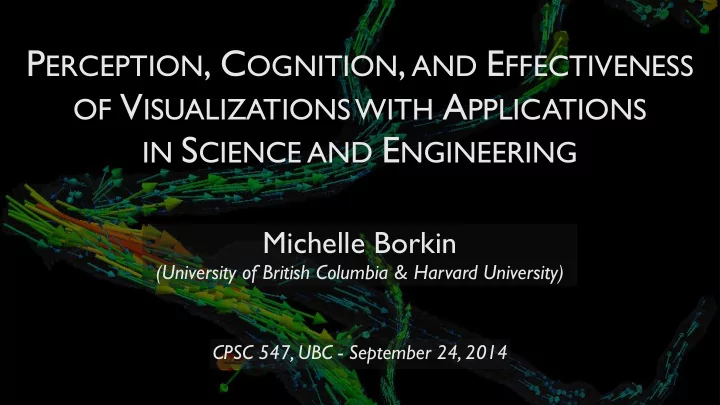

P ERCEPTION , C OGNITION , AND E FFECTIVENESS OF V ISUALIZATIONS WITH A PPLICATIONS IN S CIENCE AND E NGINEERING Michelle Borkin (University of British Columbia & Harvard University) CPSC 547, UBC - September 24, 2014
Movie Credits: NASA/CXC/MIT/D.Berry/T. Delaney et al.
Chris Beaumont, Tom Robitaille, Michelle Borkin, & Alyssa Goodman (glueviz.org)
I N P ROV M. Borkin, C. Yeh, M. Boyd, P. Macko, K. Gajos, M. Seltzer, & H. Pfister (IEEE TVCG / InfoVis 2013)
Michelle Borkin, Krzysztof Gajos, Amanda Peters, Dimitris Mitsouras, Simone Melchionna, Frank Rybicki, Charles Feldman, & Hanspeter Pfister, “Evaluation of Artery Visualizations for Heart Disease Diagnosis” (IEEE TVCG / InfoVis 2011)
N ON -I NVASIVE D IAGNOSIS Generate patient geometries Obtain patient CT data Segment arteries Patient specific Visualize and Clinical decision blood flow simulation analyze data
D ATA This can rupture and give you a heart attack! plaque very low ESS low ESS initial disease ESS = endothelial shear stress (i.e., frictional force from blood flow)
D ATA This can rupture and give you a heart attack! Low ESS = BAD plaque very low ESS low ESS cannot directly measure ESS in living patients! initial disease ESS = endothelial shear stress (i.e., frictional force from blood flow)
F ORMATIVE Q UALITATIVE S TUDY • Semi-structured interviews • 10 medical doctors and researchers • Brigham & Women’s Hospital (Boston, MA) Visualize and Clinical decision analyze data
T ASK T AXONOMY T ASK A BSTRACTION C LINICAL R ESEARCH
T ASK T AXONOMY T ASK A BSTRACTION C LINICAL R ESEARCH “Identify regions of low ESS” find extrema X X
T ASK T AXONOMY T ASK A BSTRACTION C LINICAL R ESEARCH “Identify regions of low ESS” find extrema X X “Identify stenosis or blockage” find extrema X X
T ASK T AXONOMY T ASK A BSTRACTION C LINICAL R ESEARCH “Identify regions of low ESS” find extrema X X “Identify stenosis or blockage” find extrema X X “View all ESS data for patterns” cluster X X
T ASK T AXONOMY T ASK A BSTRACTION C LINICAL R ESEARCH “Identify regions of low ESS” find extrema X X “Identify stenosis or blockage” find extrema X X “View all ESS data for patterns” cluster X X “Study blood flow velocity patterns” find anomalies X
T ASK T AXONOMY T ASK A BSTRACTION C LINICAL R ESEARCH “Identify regions of low ESS” find extrema X X “Identify stenosis or blockage” find extrema X X “View all ESS data for patterns” cluster X X “Study blood flow velocity patterns” find anomalies X “Identify regions of blood find anomalies X recirculation”
T ASK T AXONOMY T ASK A BSTRACTION C LINICAL R ESEARCH “Identify regions of low ESS” find extrema X X “Identify stenosis or blockage” find extrema X X “View all ESS data for patterns” cluster X X “Study blood flow velocity patterns” find anomalies X “Identify regions of blood find anomalies X recirculation” “Investigate other physical variables of find anomalies X blood flow”
T ASK T AXONOMY T ASK A BSTRACTION C LINICAL R ESEARCH “Identify regions of low ESS” find extrema X X “Identify stenosis or blockage” find extrema X X “View all ESS data for patterns” cluster X X “Study blood flow velocity patterns” find anomalies X “Identify regions of blood find anomalies X recirculation” “Investigate other physical variables of find anomalies X blood flow”
T ASK T AXONOMY T ASK A BSTRACTION C LINICAL R ESEARCH “Identify regions of low ESS” find extrema X X “Identify stenosis or blockage” find extrema X X “View all ESS data for patterns” cluster X X “Study blood flow velocity patterns” find anomalies X “Identify regions of blood find anomalies X recirculation” “Investigate other physical variables of find anomalies X blood flow”
3D VS . 2D
3D VS . 2D
L AYOUT AND P ROJECTIONS
C OLOR
C OLOR Preferred Too “radiological” (standard) Non-rainbow favorite!
C OLOR
Q UANTITATIVE S TUDY : G OALS 3D vs. 2D rainbow vs. diverging
Q UANTITATIVE S TUDY • 21 Harvard Medical students (12 women and 9 men) • Mixed within-subject and between-subject design: ‣ within = dimensionality of representation (2D or 3D) ‣ between = color mapping (rainbow or diverging) e.g., Participant A e.g., Participant B
Q UANTITATIVE S TUDY • Dependent measures: ‣ fraction of low ESS regions identified ‣ number of false positives (i.e., non-low ESS regions identified as low ESS) ‣ time to complete a diagnosis
Q UANTITATIVE S TUDY
Q UANTITATIVE S TUDY
Q UANTITATIVE S TUDY
Q UANTITATIVE S TUDY
R ESULTS
A CCURACY Strong effect of dimensionality on accuracy 39% 62% How many low ESS regions found?
A CCURACY Strong effect of dimensionality on accuracy ...as well as color 39% 91% How many low ESS regions found?
E FFICIENCY Participants more efficient in 2D . 5.6 sec/region 2.4 sec/region
E FFICIENCY Participants more efficient in 2D . 5.6 sec/region 2.6 sec/region
E FFICIENCY Participants more efficient in 2D . Rainbow color map has greater effect on efficiency in 3D. 10.2 sec/region 2.6 sec/region
C OMPLEXITY Accuracy decreases with increased data complexity in 3D participants less accurate
C OMPLEXITY Accuracy decreases with increased data complexity in 3D (not true in 2D!)
F INDINGS S UMMARY • Even for 3D spatial data, a 2D representation is ‣ more accurate for spatial tasks ‣ more efficient for spatial tasks • Rainbow color map ! ‣ is not accurate and not efficient ‣ has adverse effects even greater in 3D
F INAL R EMARKS • 3D representation is still essential for surgical planning • 2D tree diagram applicable to other applications
M ICHELLE B ORKIN http://bit.ly/mborkin @michelle_borkin borkin@cs.ubc.ca Research funded through the NDSEG (National Defense Science and Engineering Graduate) Fellowship Program, and the NSF Graduate Research Fellowship Program.
Recommend
More recommend